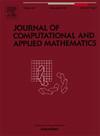模拟润湿现象的修正Cahn-Hilliard方程的二阶能量稳定数值格式
IF 2.6
2区 数学
Q1 MATHEMATICS, APPLIED
Journal of Computational and Applied Mathematics
Pub Date : 2025-09-26
DOI:10.1016/j.cam.2025.117103
引用次数: 0
摘要
本文设计了模拟润湿现象的修正Cahn-Hilliard相场模型的二阶无条件能量稳定数值格式。采用标量辅助变量法(SAV)将Cahn-Hilliard方程转化为等价形式,时间离散化采用二阶后向差分公式(BDF2),空间离散化采用有限元法(FEM)。采用松弛技术对标量辅助变量的数值误差进行了修正。证明了该方案是无条件能量稳定的。我们对平面、弯曲和粗糙基底上的润湿现象进行了几个数值实验,证明了我们提出的数值方案的能力。同时,我们还将数值格式与自适应时间步进加速策略相结合。本文章由计算机程序翻译,如有差异,请以英文原文为准。
A second-order energy stable numerical scheme of the modified Cahn–Hilliard equation for simulating wetting phenomena
In this paper, we design a second-order unconditional energy stable numerical scheme for the modified Cahn–Hilliard phase field model simulating wetting phenomenon. We use the scalar auxiliary variable (SAV) method to transform the Cahn–Hilliard equation into an equivalent form, use second-order backward difference formula (BDF2) for time discretization and finite element method (FEM) for space discretization. A relaxation technique is employed to correct the numerical errors of the scalar auxiliary variable. The scheme is proved to be unconditionally energy stable. We perform several numerical experiments for wetting phenomena on flat, curved and rough substrates, demonstrating the capability of our proposed numerical scheme. At the same time, we also combine our numerical scheme with an adaptive time stepping strategy for acceleration.
求助全文
通过发布文献求助,成功后即可免费获取论文全文。
去求助
来源期刊
CiteScore
5.40
自引率
4.20%
发文量
437
审稿时长
3.0 months
期刊介绍:
The Journal of Computational and Applied Mathematics publishes original papers of high scientific value in all areas of computational and applied mathematics. The main interest of the Journal is in papers that describe and analyze new computational techniques for solving scientific or engineering problems. Also the improved analysis, including the effectiveness and applicability, of existing methods and algorithms is of importance. The computational efficiency (e.g. the convergence, stability, accuracy, ...) should be proved and illustrated by nontrivial numerical examples. Papers describing only variants of existing methods, without adding significant new computational properties are not of interest.
The audience consists of: applied mathematicians, numerical analysts, computational scientists and engineers.

 求助内容:
求助内容: 应助结果提醒方式:
应助结果提醒方式:


